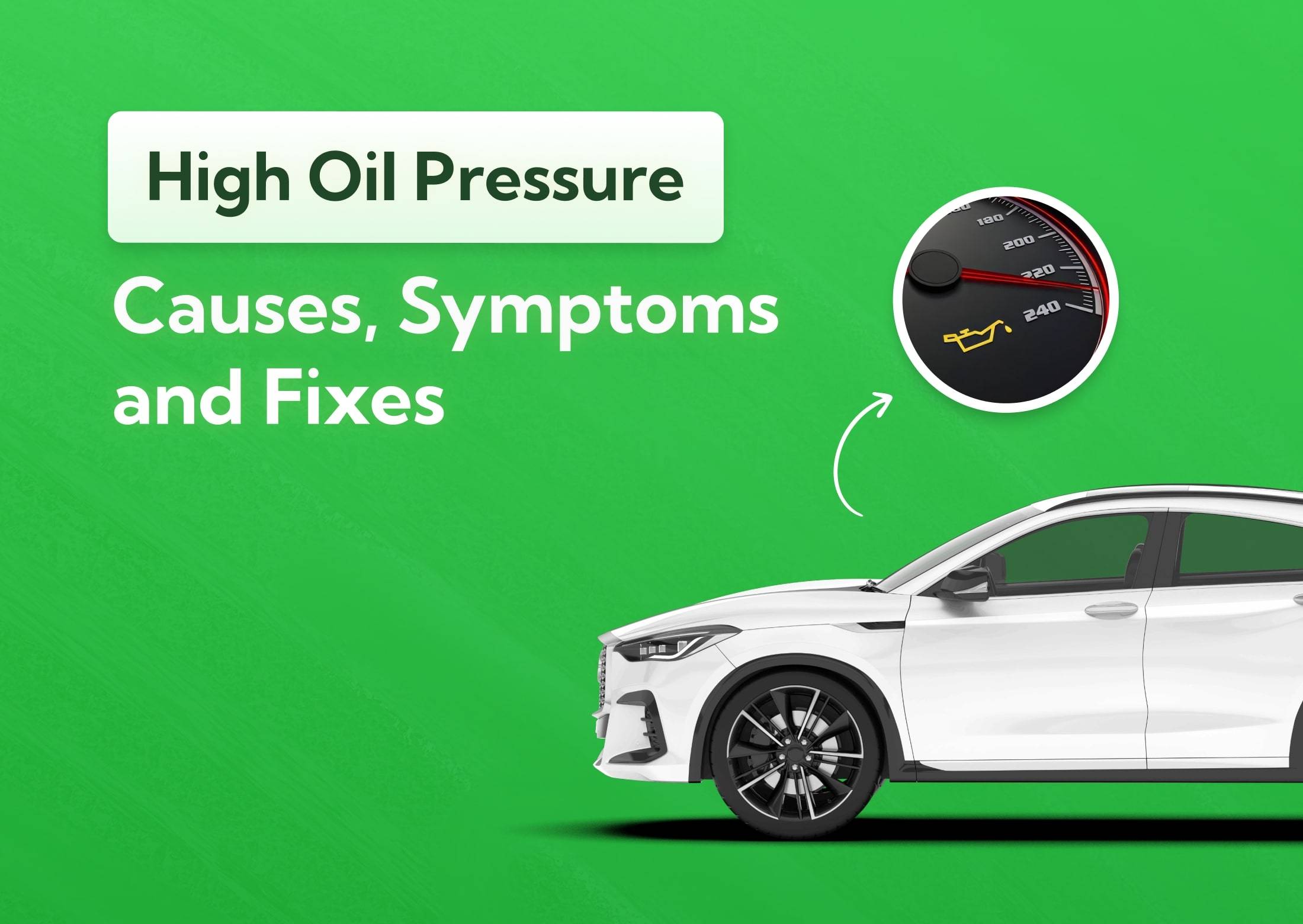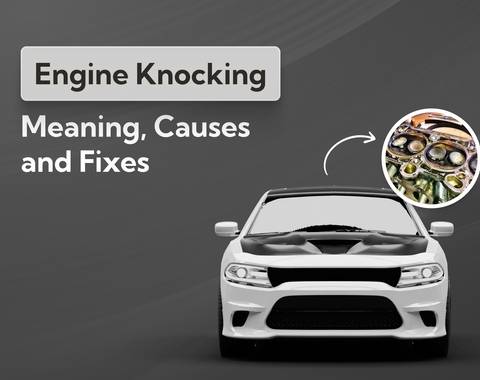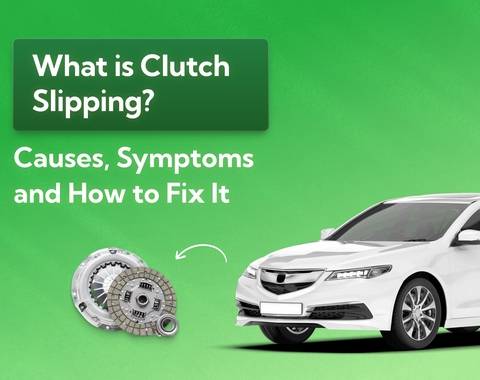High Oil Pressure: Causes, Symptoms and Fixes
High oil pressure is one of the fastest ways to wear out your engine. This guide explains what causes it, how to fix it, how much repairs cost and when it’s time to consider scrapping your car instead of pouring more money into it.
Last updated: 31st October, 2025

Award-winning automotive entrepreneur, tech innovator, and founder of Car.co.uk, NewReg.co.uk & Recycling Lives.

Listen to this story
High oil pressure is your engine’s way of saying something’s off. When the oil can’t flow freely through the system, pressure spikes. And when that happens for too long, things start wearing out faster than they should.
It usually comes down to one of a few culprits: thick or incorrect oil, a clogged filter, a faulty pressure sensor, or a failing relief valve in the oil pump. Cold weather and neglected oil changes can make it worse.
The signs? A red oil warning light that refuses to go away, noisy lifters or valves, or gauge readings higher than normal even after the engine warms up. Ignore those, and you’re looking at serious damage.
Fixing high oil pressure isn’t rocket science, though. It’s about isolating the cause. Sometimes it’s as simple as changing the oil and filter. Other times, you’ll need to swap the sensor or repair the pump itself.
Let’s break down the details so you can figure out what’s going on under the bonnet, and what to do about it before it turns into a bigger (and much pricier) problem.
What's in this article
- 3. How to fix high oil pressure
- 4. Costs of fixing high oil pressure issues
- 5. When should you consider scrapping your car due to high oil pressure?
- 5.1 When repair costs exceed the value of your car
- 5.2 Permanent engine damage from high oil pressure
- 5.3 Recurring high oil pressure problems
- 5.4 Vehicle age and condition
- 5.5 Preventive maintenance tips to avoid high oil pressure
- 5.6 Get regular oil changes.
- 5.7 Choose the correct oil viscosity.
- 5.8 Monitor oil levels and pressure regularly.
- 5.9 Maintain a healthy oil pump and relief valve.
What are the causes of high oil pressure?
High oil pressure happens when oil can’t move through the engine as freely as it should. The system’s designed to keep things balanced; enough pressure to lubricate, but not so much that it strains seals or gaskets.
When the balance tips, there’s always a reason behind it. If you have high oil pressure, the reason is usually that the filter is clogged, you’re using the wrong oil viscosity, you have a faulty oil pressure sensor, the oil pump or relief valve is bad or the oil levels are too high.
Clogged oil filter
Over time, oil filters collect sludge, metal fragments and carbon deposits. That’s their job, but eventually they get so blocked that oil has to force its way through. Some filters come equipped with bypass valves that open when pressure builds too high but if that valve fails, pressure just keeps climbing. It’s like trying to breathe through a soaked towel.
This one’s among the easiest to fix. Just clean out the oil filter or replace it.
Incorrect oil viscosity
Oil that’s too thick doesn’t flow easily, especially on cold starts. If you’ve used the wrong viscosity (say, 20W-50 instead of 5W-30), the pump has to work harder, which causes pressure to rise. It’s a simple mistake, but it can mess with your readings and wear out seals faster than you’d think.
Faulty oil pressure sensor
Sometimes the issue isn’t mechanical at all. Sensors sometimes wear out, get clogged and corrode internally. A bad sensor can send false high-pressure readings that make it seem like something’s wrong when it isn’t. If your oil light flickers or shows odd spikes, this is one of the first things to test.
Faulty oil pump or relief valve
Inside the oil pump is a relief valve that regulates pressure. When that valve sticks closed (often due to debris or poor maintenance) pressure skyrockets. The pump itself might also be worn or misaligned, causing it to over-deliver oil to the system.
If you notice your engine overheating or unusual noises (like ticking or knocking), you’ll want to get that checked quickly because a bad oil pump can spiral fast.
Excessive oil levels
It sounds harmless, but overfilling your engine causes the excess oil to foam because tiny air bubbles that reduce the oil’s ability to flow and lubricate properly. The pump reacts by pushing harder, then pressure rises and you end up with a mess that can damage seals and bearings. Always stick to the dipstick to avoid this.
What are the signs of high oil pressure?
You’ll usually know when oil pressure’s higher than it should be because your car won’t stay quiet about it. Modern engines are wired to throw warning lights if something’s off, and they’ll definitely behave differently when something’s wrong with lubrication. If you pay attention early, you can save yourself a major headache (and probably a few hundred quid).
Dashboard warning light
That little red oil can icon on your dashboard isn’t decorative. If it lights up or flickers when you’re driving, pull over as soon as it’s safe. It could be a pressure sensor fault, but it could also mean your engine’s struggling to circulate oil properly. If it’s the latter and you do ignore it, your engine will overheat and your car might break down.
Oil pressure gauge readings
Warning lights are standard on most modern cars, but if your car has an oil pressure gauge, it’s one of the best early-warning systems you’ve got.
A healthy engine will usually sit between 25 and 65 PSI once it’s warmed up; lower when idling, higher when you’re accelerating. On startup, it’s normal for readings to spike briefly before settling down.
If that needle stays high even after a few minutes of driving, or climbs beyond 80 PSI, something’s restricting flow or forcing the pump to overwork. And that’s not good.
The key here is consistency. Sudden fluctuations, abnormally high readings, or changes from your car’s usual “normal” range often signal a developing issue, like a clogged filter, the wrong oil grade or a failing relief valve.
Unusual engine noises or vibration
When oil can’t flow evenly, the top end of the engine (lifters, valves, camshaft) starts getting starved of proper lubrication. You’ll hear ticking, knocking or metallic tapping from the excess friction. Or sometimes the engine just feels rougher or louder than normal.
The reason you want to detect this early is that the friction eventually heats up your engine to the point where it welds your moving engine components together. At that point, it’ll seize and you’ll need to replace the whole thing.
Increased engine temperature
Oil carries heat away from moving parts like the pistons, bearings, and camshaft, then releases that heat back into the sump where it can dissipate safely.
When oil pressure is too high, the circulation slows down. The oil can’t move freely through the narrow channels inside the engine, so less heat gets transferred out. Thick or restricted oil also lingers longer around hot components, which makes temperatures climb even more.
You might notice your dashboard’s temperature gauge creeping up or the fan kicking in more often. It might be subtle at first, but prolonged high oil pressure will push the engine closer to overheating territory, which is why you want to pay close attention to this.
Difficulty starting the engine
When oil pressure is too high, it normally points back to the oil pump or its built-in relief valve. If that valve sticks closed, the pump pushes oil with too much force through the system, creating resistance that makes cold starts harder and cranking slower.
You might feel the starter labouring or notice the engine taking a few extra seconds to catch. It’s easy to dismiss as a weak battery, but it’s worth paying attention to. That extra strain on startup accelerates wear on bearings, seals and even the pump itself.
How to fix high oil pressure
Fixing high oil pressure starts with figuring out what’s causing it. Sometimes it’s an easy win like a dirty filter or wrong oil grade. Both of those you can sort yourself. Other times, it’s deeper in the system and best left to a mechanic with the right tools.
Either way, don’t sit on it. High oil pressure is stress building inside your engine. The longer you wait, the higher the risk of seal damage, leaks or worse, total pump failure.
Replacing or cleaning a clogged oil filter
Start simple. If your oil filter’s blocked, pressure builds fast because oil can’t circulate properly. Check when it was last changed. If it’s overdue, replace it straight away. Most filters are cheap (between £5 and £25) and easy to swap with basic tools.
The process is easy:
- Park the car on ground level. Turn it off and let it cool for 15 to 20 minutes.
- Gather your tools and materials. You’ll need a new oil filter, the correct grade of engine oil, a filter wrench (or strap), a drain pan and a rag or gloves.
- Locate the old filter. Most filters are under the engine near the oil pan, though some are mounted on top. Check your owner’s manual if you’re unsure.
- Position the drain pan. Place it beneath the filter. Some oil will spill out when you remove it.
- Remove the old filter. Use your hand or the wrench to twist the old filter anti-clockwise. Be ready for a bit of warm oil to drip down.
- Prepare the new filter. Before fitting it, dab a small bit of clean oil on the rubber gasket of the new filter. This helps it seal properly and makes future removal easier.
- Install the new filter. Screw it on by hand until it’s snug, then give it about a three-quarter turn more. Don’t overtighten because that can damage the gasket.
- Top up the oil. Use the dipstick to confirm it’s at the correct level.
- Start and check. Run the engine for a minute, then switch it off and check forleaks around the filter. If it’s dry and secure, you’re good.
While you’re at it, inspect the old filter for debris or metal flakes; they can hint at deeper issues. If the problem clears after replacing it, great. But if the new filter clogs again quickly, that’s your cue to dig deeper into possible sludge build-up or internal wear.
Switching to the correct oil viscosity
If you’re using oil that’s too thick, your pump has to push harder to move it through the engine. The fix here is straightforward: drain the old oil and refill with the correct viscosity recommended by your car’s manufacturer.
Check the owner’s manual or the oil cap for your vehicle’s specifications. You’ll see something like 5W-30 or 0W-40 printed there. That’s your target. The first number (“5W”) tells you how the oil flows in cold conditions; the second (“30”) is how it performs once the engine’s hot.
Once you switch to the proper viscosity, your gauge readings should stabilise and your engine will thank you for it.
Replacing a faulty oil pressure sensor
A bad oil pressure sensor can make it look like your engine’s under pressure (literally) when it’s not. If your oil light flickers, stays on even after checking oil levels or your gauge jumps between extremes, that’s your first clue.
To confirm it’s the sensor, connect an OBD-II scanner and check for error codes related to oil pressure or the sensor circuit. If the codes show up, or if the readings don’t match a manual pressure test done at the oil port, it’s time to replace it.
How to replace the sensor:
- Locate the oil pressure sensor. It’s usually near the oil filter or screwed into the engine block.
- Disconnect the battery.
- Unplug the sensor’s electrical connector.
- Use an appropriate socket (generally a deep one) to unscrew the old sensor.
- Install the new sensor and tighten it gently. Don’t overtighten as it’s delicate.
- Reconnect the plug and battery, then start the engine to confirm the light or gauge now behaves normally.
Remember that accurate oil pressure readings are essential. The gauge tells you whether your engine’s being properly lubricated or is seconds away from damage. A £20 sensor can literally save you from a £2,000 repair bill, so never ignore strange readings.
Repairing or replacing the oil pump or relief valve
If you hear knocking noises, see persistently high pressure readings, or notice the gauge spiking even after an oil change, the oil pump or its built-in relief valve could be the culprit. These parts control how oil circulates and regulate pressure, so when they fail, the whole system goes out of balance.
If you need to repair or replace them:
- Drain the oil and remove the oil pan. This gives access to the pump assembly.
- Inspect the pump gears and housing. Look for scoring, debris, or signs of wear.
- Check the relief valve spring and plunger. If the valve’s stuck closed or the spring is weak, pressure will stay high.
- Clean or replace the faulty components. Often it’s more cost-effective to replace the entire pump rather than attempt a patch job.
- Reinstall and torque everything to spec. Then refill with fresh oil and run the engine, watching for stable pressure readings.
The oil pump and relief valve are your engine’s circulatory regulators. They keep the flow steady and pressure within a safe range. Without them working properly, oil either can’t reach key components or floods the system under too much force, both of which destroy bearings and seals over time.
Important note: This is NOT a DIY job unless you’re highly experienced. It requires engine disassembly, which has to be done by a skilled mechanic.
Draining excess oil
Too much oil leads to foaming, high pressure and even seal damage, so it’s worth fixing right away. Fortunately, draining the excess is quick and simple if you do it safely.
The steps you need to take:
- Let the engine cool. Hot oil burns, so give it at least 15 to 20 minutes.
- Locate the drain plug. It’s at the bottom of the oil pan underneath the car.
- Position a drain pan. Place it directly under the plug to catch what comes out.
- Loosen the plug slowly. Don’t remove it completely, though. Crack it just enough to let a small stream of oil flow out.
- Check the dipstick often. Stop draining once the level drops between the “min” and “max” marks.
- Tighten the plug. Wipe off any spills and make sure the seal’s snug, not overtightened.
- Start the engine briefly. Then recheck the dipstick to confirm the level’s perfect.
Never try to “burn off” excess oil by driving, because that’ll strain the engine and damage your catalytic converter.
Costs of fixing high oil pressure issues
The cost of fixing high oil pressure depends entirely on what’s behind it. If you’re lucky, it’s a cheap sensor or a clogged filter, a quick £20 to £60 job you can do yourself. But if the problem runs deeper, like a failing oil pump or a jammed relief valve, you’re looking at several hundred pounds in parts and labour.
In short: simple fixes cost pocket change, mechanical ones don’t.
| Repair type | Typical cost | Notes |
|---|---|---|
| Oil pressure sensor replacement | £50 to £150 | Cheap part (£3.50+) but labour drives cost up |
| Oil pump and relief valve replacement | £300 to £2,000+ | Parts under £400; labour-heavy (4–10+ hours) |
| Oil and filter change | £100 to £200 | Simple and often effective fix; depends on oil type and garage |
Sensor replacement cost
Replacing an oil pressure sensor in the UK usually costs between £50 and £150, depending on your car’s make and model and where you get it done. The sensor itself can be as cheap as £3.50, but labour drives up the total.
Costs rise if the sensor’s buried deep in the engine, the garage’s hourly rate is high (e.g. in Central London vs the suburbs) or the mechanic spends extra time diagnosing the issue. Luxury and performance cars also use pricier OEM parts.
Still, it’s one of the cheaper oil-pressure fixes — and sorting it early can save you thousands if it prevents a misdiagnosed oil pump failure later on.
Oil pump and relief valve replacement cost
Replacing an oil pump and relief valve in the UK can cost anywhere from £300 to over £2,000 depending on the car’s design and how buried the pump is in the engine bay. The pump and relief valve will normally cost less than £400, but labour dominates the bill; it takes anywhere from 4 to 10+ hours to reach and replace it.
For engines with front-mounted, easily accessible pumps, expect around £300 to £800 all in. But on tightly packed engines (like those in smaller sports cars) mechanics need to remove major components just to get to the pump, pushing total costs well past £1,000.
Oil filter and oil change costs
An oil and filter change is the simplest fix for high oil pressure (and thankfully, one of the cheapest). In the UK, you’ll usually pay £100 to £200 depending on the vehicle, oil type and where you go.
Synthetic oils cost more but protect better and garages charge extra for premium filters. According to data from RAC Mobile Mechanics the 2025 average hovers around £160. If you’re handy, doing it yourself can drop the cost to under £40, including materials.
Regular changes every 5,000 to 7,500 miles are the most essential aspect of your routine servicing, though. They prevent sludge build-up, which is the very thing that clogs filters and spikes oil pressure in the first place. Cheap maintenance, expensive problems avoided.
When should you consider scrapping your car due to high oil pressure?
Of course, high oil pressure isn’t always a death sentence for your car. But sometimes, the repair costs or long-term risks simply don’t make financial sense. If fixing the issue would cost more than the vehicle’s worth or if it’s part of a deeper mechanical decline, scrapping is the smartest call.
Let’s take a look at when I’d recommend you scrap your car:
When repair costs exceed the value of your car
If the repair quote is £1,000+ and your car’s only worth £800, the maths makes the decision for you. Even if it’s technically fixable, sinking more into repairs than resale value never pays off. In fact, it ends up costing you more down the road.
What the experts say

Anthony Sharkey
Permanent engine damage from high oil pressure
Running with excessive pressure for too long irreversibly destroys bearings, seals and internal oil channels. Once that happens, you’re not looking at a simple fix anymore. It’s going to be a full engine rebuild or replacement, which will run you £1,500 to more than £6,000. At that point, scrapping is the more logical and cost-efficient option unless the car’s brand new.
Recurring high oil pressure problems
If you get a new sensor, oil change, pump replacement and it still spikes, that’s a sign of chronic internal wear or a critical design flaw. Ongoing repairs here will drain your wallet fast. Scrapping stops the bleed and lets you put that money toward a reliable replacement.
Vehicle age and condition
Older cars naturally have more internal wear, weaker seals and oil channels that clog easier. If yours already needs frequent top-ups, new gaskets or fails emissions tests, recurring oil pressure issues are just another symptom of an engine nearing its end.
According to Car.co.uk internal data after scrapping more than 130,000 cars, the vast majority fall into the 16 to 20 year range. So if your car’s pushing 15+ years, it’s probably time to scrap it even if you think it’s in rock solid condition.
Preventive maintenance tips to avoid high oil pressure
The best way to deal with high oil pressure is to stop it from happening in the first place. In my experience, most pressure spikes come from neglect. Old oil, clogged filters and skipped maintenance slowly strangle the engine’s flow.
A few simple habits keep your oil system clean, healthy and balanced so you’re never dealing with pressure problems or warning lights in the first place.
Get regular oil changes.
I can’t stress this enough. Old oil thickens over time and collects debris that can clog filters and passages. Stick to regular oil changes. Every 5,000 to 7,500 miles for most vehicles, or sooner if you drive short trips or in stop-start traffic. Fresh oil keeps flow consistent and pressure stable.
Choose the correct oil viscosity.
Always follow the viscosity grade recommended in your owner’s manual. Using oil that’s too thick (like 20W-50 when 5W-30 is required) makes cold starts harder and increases pressure. The right viscosity ensures smooth circulation, better protection, and balanced oil pressure across temperatures.
Monitor oil levels and pressure regularly.
Check your oil level at least once a month and after long drives. If your car has an oil pressure gauge, glance at it occasionally. If not, an oil pressure gauge kit costs £20 to £30 on Amazon. Sudden jumps or readings higher than usual mean it’s time to investigate before a minor issue becomes a major one.
Note: After you get your oil changed or whenever you top it up, make sure not to overfill it either. Too much oil leads to high pressure.
Maintain a healthy oil pump and relief valve.
Your oil pump and relief valve quietly handle one of the most important jobs in the engine, which keeps the oil pressure steady. When either one starts to wear or stick, problems build fast.
During regular servicing, ask your mechanic to inspect oil flow pressure with a manual gauge. Uneven or fluctuating readings point to a weak pump or a relief valve that isn’t opening correctly. Also check for metal shavings in the oil filter or sump (an early sign of internal wear).
A few maintenance tips:
- Stick to the right oil viscosity and change intervals.
- Use the highest-quality filters; cheap ones can collapse or restrict flow.
- If you drive an older car, have the oil pump inspected during every major engine service.
- Avoid engine flushes unless recommended because they can dislodge debris that clogs the relief valve.
Frequently asked questions
Yes, indirectly. When oil pressure is too high, the pump works harder than it should, creating extra drag on the engine. That resistance uses more power and, over time, slightly reduces fuel efficiency. It’s not massive, but if your oil’s too thick or your pump’s overworking, you’ll feel it at the pump.
You cannot drive with the high oil pressure light on. That light means your engine’s lubrication system isn’t working properly. Driving with high pressure damages seals, gaskets and bearings. Pull over as soon as it’s safe, turn off the engine and check your oil level.
If you choose to drive anyway, know that you are at a significant risk of severe and permanent engine damage. That includes complete engine failure. Even if you think it looks fine, it’s normally better to have it towed instead of risking driving it.
Make a habit of paying attention to your dashboard gauge or warning light every time you drive. If your car doesn’t have a gauge, check the oil levels and pressure manually once a month and after long trips. Consistent readings are key. If you spot sudden jumps, high readings or fluctuating pressure, get it looked at.
The relief valve is the system’s pressure regulator. When oil pressure gets too high, it opens to let excess oil flow back into the sump, keeping the system balanced. If it sticks closed, pressure spikes and parts wear out. If it sticks open, you risk low oil pressure instead.
About Car.co.uk

Share on
Latest news & blogs










